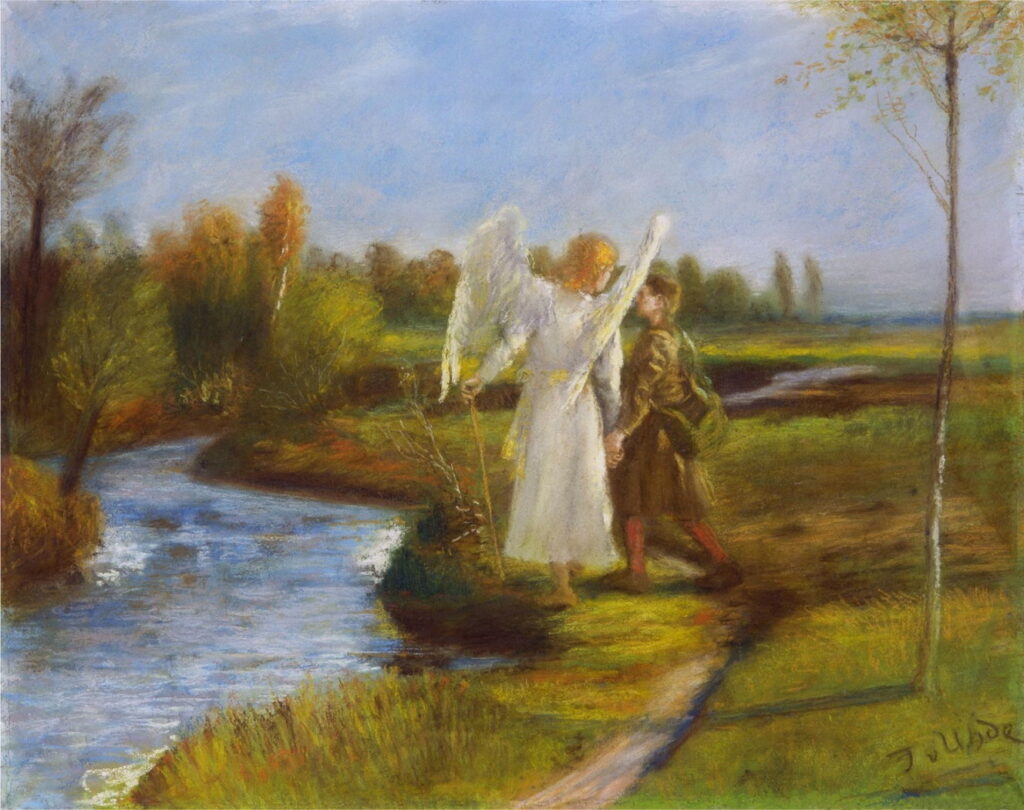Reading visual art: 145 Divine flight

Just as humans have always wanted to fly, the ability has commonly been ascribed to those elevated to the status of god or goddess. While some systems of belief have been happy to award all their deities the power of flight, it was more restricted in those of the ancient Mediterranean civilisations responsible for most of the myths painted in European art.
Charles-Antoine Coypel (1694–1752), The Fury of Achilles (1737), oil on canvas, 147 x 195 cm, Hermitage Museum Государственный Эрмитаж, Saint Petersburg, Russia. Wikimedia Commons.
Charles-Antoine Coypel’s Fury of Achilles from 1737 captures Achilles, wearing his elaborate armour in the centre, as he’s being aided in the war against Troy by Athena on the left and Hephaestus on the right. Further to the right is Scamander, shown traditionally with his large jar gushing water and a wooden paddle in his right hand. Beneath them are the bodies of Trojans, and the river is starting to run red with their blood. In the more distant chariot is Hera with one of her peacocks.
More generally, though, unlimited free flight was confined to Hermes/Mercury, messenger of the gods, Cupid, and those personifying features of the sky, including the winds, heavenly bodies such as rainbows (Iris, another divine messenger), and events like night.
Pierre-Auguste Renoir (1841–1919), The Judgment of Paris (c 1908-10), oil on canvas, 73 x 92.5 cm, Hiroshima Museum of Art, Hiroshima, Japan. Wikimedia Commons.
Pierre-Auguste Renoir painted The Judgement of Paris late in his long career, in 1908-10. Its three slightly soft-focus nudes are shown against a blurry background of countryside. Paris has accepted Aphrodite’s bribe, and is here awarding her the golden apple. Watching on is Hermes, complete with his winged helmet and sandals signifying his flying ability, and his distinctive caduceus.
Edward Burne-Jones (1833–1898), The Perseus Series: The Death of Medusa II (1881-2), bodycolour, 152.5 × 136.5 cm, Southampton City Art Gallery, Southampton, England. Wikimedia Commons.
The sixth painting in Edward Burne-Jones’ Perseus series, The Death of Medusa II (1881-2), completes the story of Medusa by showing the hero fleeing from the Gorgons. The headless body of Medusa is left on the ground, and her sisters fly around searching for her assailant. Perseus wears the helmet of Hades to maintain his invisibility, and is flying away with his borrowed winged sandals, while inserting Medusa’s head in his kibisis.
Sandro Botticelli (Alessandro di Mariano di Vanni Filipepi), Primavera (Spring) (c 1482), tempera on panel, 202 x 314 cm, Galleria degli Uffizi, Florence. Wikimedia Commons.
Sandro Botticelli’s huge masterpiece Primavera (Spring) demonstrates this differentiation, in its retelling of the story of Zephyrus and Flora. The west wind (far right, and detail below) abducted and raped the nymph Chloris (to the left of him), who was then transformed into the goddess Flora, who is dressed and decked in flowers, representing the Spring. Only Zephyrus as a wind, and Cupid above, are shown in flight.
Sandro Botticelli (Alessandro di Mariano di Vanni Filipepi), Primavera (Spring) (detail) (c 1482), tempera on panel, 202 x 314 cm, Galleria degli Uffizi, Florence. Wikimedia Commons.
Charles William Mitchell (1854–1903), The Flight of Boreas with Oreithyia (1893), further details not known. Wikimedia Commons.
Charles William Mitchell’s The Flight of Boreas with Orithyia from 1893 gives a full and classical account of this myth. Orithyia is trying to push the head of her abductor away, and unfasten his right hand from her thigh, but Boreas is just about to take her airborne.
Another deity whose role in mythology depends on her ability to fly is Eris, whose spreading of discord among the goddesses was key to the origin of the war against Troy.
Jacob Jordaens (1593–1678), The Golden Apple of Discord (1633), oil on canvas, 181 × 288 cm, Museo Nacional del Prado, Madrid, Spain. Wikimedia Commons.
In Jacob Jordaens’ Golden Apple of Discord (1633), the facially discordant Eris, seen in midair behind the deities, has just made her gift of the golden apple, now at the centre of the grasping hands above the table. At the left, Minerva (Pallas Athene) reaches forward for it. In front of her, Aphrodite, her son Eros at her knee, points to herself as the goddess most deserving of the apple. On the other side of the table, Hera reaches her hand out for it too.
Flying ability wasn’t evenly distributed in Norse mythology either, but was a skill best developed among valkyries.
Edward Robert Hughes (1851–1914), Dream Idyll (A Valkyrie) (1902), gouache and pastel on paper, 109.5 × 79 cm, Private collection. Wikimedia Commons.
Edward Robert Hughes’ first work showing a valkyrie from Norse mythology, Dream Idyll (A Valkyrie) from 1902, depicts a naked and unarmed woman riding a winged horse in the sky over a late Victorian city, perhaps London.
This has perpetuated into more recent myths and legends of fairies and related little creatures.
Domenicus van Wijnen (1661–1698), Allegorical Scene (1680-90), oil, dimensions not known, Private collection. Wikimedia Commons.
This Allegorical Scene looks like one of the more extreme faerie works from Victorian Britain, but was painted by Domenicus van Wijnen almost two centuries earlier. At the upper right, hundreds of small putti-like fairies are being ejected from below, flying in an arc over the top of the painting, and coalescing around a goddess lit brightly from behind. Below her is a river, where large numbers of naked bathers are congregated, and they too appear to rise up into the sky in another stream of flying figures.
These have been perpetuated in Christian beliefs in the form of angels, whose wings have more ancient and pre-Christian origins.
Hieronymus Bosch (circa 1450–1516), Ascent of the Blessed, panel from Visions of the Hereafter (c 1505-15), oil on oak panel, 88.8 x 39.9 cm, Museo di Palazzo Grimani, Venice. Wikimedia Commons.
Hieronymus Bosch’s panel Ascent of the Blessed is one of the four making up his Visions of the Hereafter (c 1505-15), with particularly original and beautiful winged angels. These wings enable clear distinction to be made between humans and other human-like creatures, and the messengers of God. Being messengers, just as older gods like Eros, Thanatos, and Vanth before them, there’s a feasible rationale for them requiring their wings in order to move swiftly from heaven or the pre-Christian underworld to earth, and in their duties on earth.
There are even a few instances of divine and saintly figures being awarded the gift of flight.
William Blake (1757–1827), The Nativity (1799-1800), tempera on copper, 27.3 x 38.2 cm, Philadelphia Museum of Art (Gift of Mrs. William Thomas Tonner, 1964), Pennsylvania, PA. Courtesy of The Philadelphia Museum of Art.
William Blake’s unusual Nativity of 1799-1800 shows Joseph (left) supporting the Virgin Mary, who appears to have fainted. Jesus has somehow sprung from her womb, and hovers, arms outstretched as if ready for crucifixion, in mid-air. On the right, Mary’s cousin Elisabeth greets the infant, with her own son, John the Baptist, on her lap.
Jacopo Tintoretto (1518-1594), Miracle of the Slave (1548) (E&I 46), oil on canvas, 415 x 541 cm, Gallerie dell’Accademia, Venice, Italy. Image © José Luiz Bernardes Ribeiro / CC BY-SA 4.0, via Wikimedia Commons.
The occasional saint has been awarded their licence to fly, as shown here in the figure of Saint Mark in Tintoretto’s early success Miracle of the Slave from 1548. Here the artist’s intention is not just about motion, but about the act of flying, and the figure’s saintliness or divinity.




